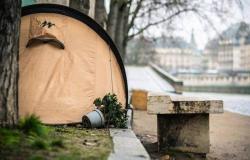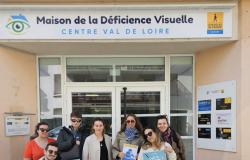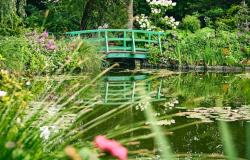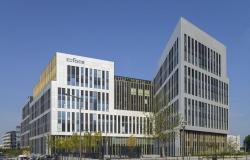
In the Bagnolet wrestling room, lined up trash cans collect the water that flows from the ceiling.
NINA WAECHTER
Facebook Twitter E-mail Copy link
Send
Free access
Decryption Seine-Saint-Denis is the department least equipped with sports facilities in the country. If the 2024 Olympic and Paralympic Games promised to leave a legacy for the population, one month before the event, the territory is still experiencing significant structural difficulties, in particular for school sport.
“I don’t even notice the cold anymore, I’ve gotten into the habit of having four jackets in winter”, says a PE teacher at the Marie Curie des Lilas college (93). He teaches in one of the three tennis halls in the town, the least well insulated. “There is water flowing in the gymnasium, we put bins to collect the water”the teacher continues.
Read also
The 2024 Olympics, a springboard towards Los Angeles 2028 for young athletes from Seine-Saint-Denis
Free access
Read later
In the department, sports stakeholders have been warning about the deterioration of equipment for years. There are on average 16 sports facilities per 10,000 inhabitants, according to the Ministry of Sports website, for a national average of 40 facilities. “There is a serious lack of sports practice”recognizes Emmanuel Constant, responsible for education and the Olympic and Paralympic Games at the departmental council of Seine-Saint-Denis.
This makes it the least well endowed department in the country, while it also has the youngest population in France. While Seine-Saint-Denis will host numerous events, the Olympic and Paralympic Games have been presented as an accelerator for the construction and renovation of infrastructure. But less than a month before the Games, reality is disappointing.
“The ax falls without warning”
One kilometer from Les Lilas, at the Briqueterie sports park in Bagnolet, the running track made of cinder earth is uneven, and after a day of rain, large puddles cover it. In the wrestling room, the radiators are rusty, the walls and ceiling are crumbling, the floor is uneven. “The buckets aren’t just to look pretty, there have been leaks for weeks”adds Clara, PE teacher in the department. “What conditions are given to teachers? she asks. Either the equipment is obsolete, and it is up to us to tinker, or it is not accessible to schools. »
Read also
Seine-Saint-Denis: a medical center welcoming undocumented immigrants will close during the Olympics
Free access
Read later
According to her, the saturation of equipment constitutes “a new injustice for the children of 93”.
“In Montreuil, Bondy or Bobigny, there can be five or six establishments on one installation. There can be eight classes on the same athletics track. »
A situation that is all the more damaging as PE is for many young people “the only opportunity to play sports” : “It’s a social inclusion issue.”
Without the students in the locker rooms and on the pitch, the Rigondes stadium in Bagnolet would appear abandoned. NINA WAECHTER
The lack of infrastructure is particularly significant for swimming pools, as half of the children in the department do not know how to swim when they start sixth grade, as revealed by the Savoir nager survey in 2021. “All the colleges in the department share 90 hours of access to the swimming pools”explains Clara. The Marie-Curie college in Les Lilas, for example, only has one hour of swimming per week. Of the six sixth-grade classes, two do not have access to it at all, says the teacher.
This deficiency can be aggravated by unexpected closures. “The facilities are gradually deteriorating, and the ax falls without warning”, notes Clara. As in Romainville where the ax fell on May 24: studies prior to a renovation project revealed lead pollution in the embankments of the Stalingrad stadium, dating from the 1950s and used by the Pierre-André Houël college. The Regional Health Agency has recommended a temporary closure. “Temporary solutions have been found for students, who will have access to other equipment”, says Tony Laïdi, sports assistant at town hall. The gymnasium attached to the stadium, “too dilapidated”has been closed for three months.
A lack of resources noted by the Court of Auditors
“The department’s infrastructures are on average forty years old”explains Serge Reitchess. A former PE teacher, he is also a member of the Permanent Collective for the Defense and Promotion of PE, School Sport and the Sports Movement in Seine-Saint-Denis (Coper 93), associated with the Snep-FSU 93 union. The collective, created three years ago, warns of the lack of equipment and the difficulty of access to sport for young people. With the Olympic Games approaching, he wants to show “the abysmal gap between the flashiness of communication and reality [que vivent] the inhabitants ».
Read also
Olympic Games in Seine-Saint-Denis: associations concerned about the health of the most vulnerable
Free access
Read later
The Coper 93 asks “structural measures” and in particular a financial allocation adapted to the department. In a March 2023 report, the Court of Auditors deplores that the amount of the departmental allocation of college equipment “is unrelated to the number of students and the size of school buildings”. That “penalizes” urban departments, young and populated, such as Seine-Saint-Denis which sees “its investment expenses covered to the tune of only 9.28%”, compared to 15.61% at the national level. “State support for the construction of facilities is very low”, confirms Emmanuel Constant. A larger endowment “would provide more support to municipalities for implementation and renovation”.
A legacy promised to the population
Can the momentum of the Olympics help overcome these difficulties? Investments do exist, but do not always concern school use. The State has put in place a plan aimed at building “5,000 local devices” nationally by 2024. With a budget of 200 million euros, this amounts to 40,000 euros per installation on average. “This is for light equipment, such as street gyms, not large-scale projects such as stadiums and gymnasiums.”explains Hugo Pontais, also a member of Coper 93. “We are very far from the needs.”
Larger investments have also been made. This is what Martin Citarella, planning and institutional advisor to the departmental Olympic and sports committee of Seine-Saint-Denis (CDOS), notes. He cites the renovation of the Grande Nave of Île-des-Vannes or the construction of the Olympic Aquatic Center, for 175 million euros.
“The legacy of the Olympic Games will not solve the structural deficiencies from which the department suffers, but it is tangible.”
Emmanuel Constant also salutes a “accelerator stroke real ” more “insufficient to solve the problems.” “Without the Games, we would have ended up with the same improvements, but in thirty years instead of seven. We are not satisfied with that, but it already has a real effect on the lives of children.”
The challenge now is effective access for students to new equipment, some of which is private. “We will be vigilant as to how the equipment will be managed”adds Martin Citarella.
Thinking about the post-Olympics
“With the Games, we are establishing elite sports structures among the poor without taking into account local needs”believes Serge Reitchess. For him, “the legacy of the Games was not anticipated with the population”.
Read also
Reportage Cultural Olympiad: Young people from Seine-Saint-Denis do not back down
Free access
Read later
Among the demands of the Coper 93, a “catch-up plan” of 6 billion euros to compensate “the structural delay of the department and the strong territorial inequalities in terms of sports practice”. The figure corresponds to the initial budget for the Games in the Paris bid file. “For every euro spent on the Games, we also want a euro for the population”sums up the former teacher.
The collective organized a citizens’ convention at the National Assembly on June 13, and hopes to be received by the Ministries of Sports and National Education at the start of the school year. Above all, he wants to maintain mobilization after the Games. Martin Citarella also thinks about the future:
“The Games have put the subject of access to sport on the table: they must now be the trigger for in-depth reflection.”
It’s necessary “capitalize” on the event. “The mistake we should not make is to look away from Seine-Saint-Denis in September. » Emmanuel Constant indicates having “pass the message to Amélie Oudéa-Castéra” : “Support for the sports movement must not stop after the Games.”
Seine-Saint-Denis at Olympic time, with IPJ Dauphine-PSL
This article is part of a report produced by a group of first-year students from the IPJ Dauphine-PSL journalism school in Paris, in partnership with “New Obs”. Urban planning, culture, education, health, sports… As part of a week of reports and investigations at the end of May, these young journalists went to probe the doubts and hopes of the inhabitants of Seine-Saint-Denis, at the he approach of the Olympic Games, part of the events or the logistics of which take place in the department.
On the subject I of Paris 2024





